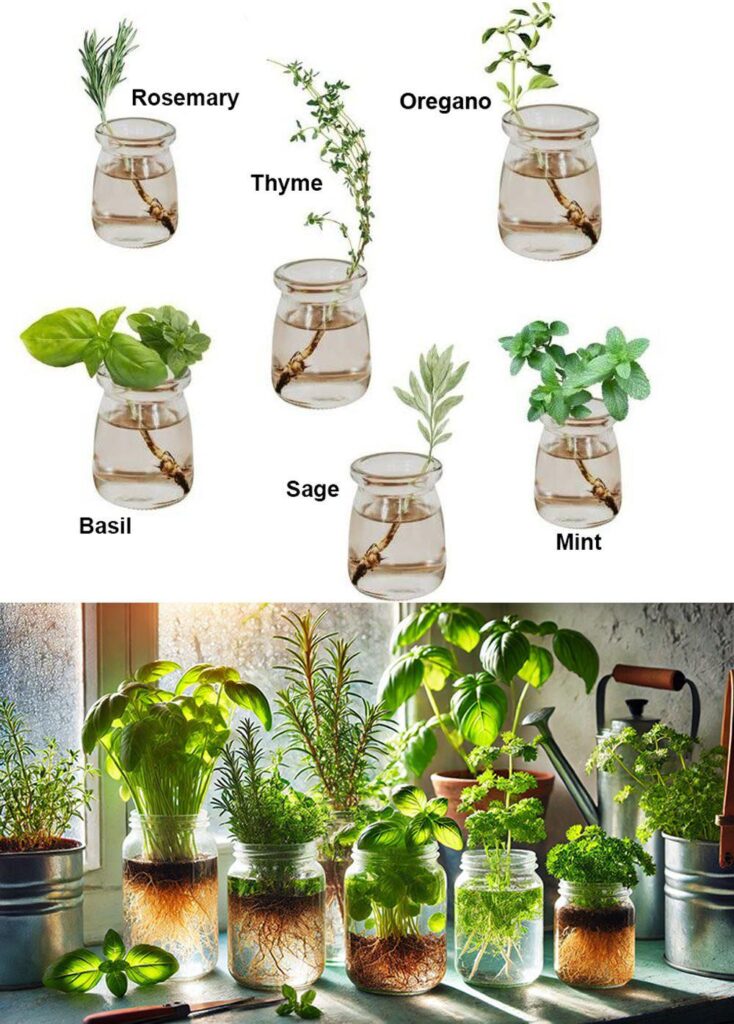Growing Herbs in Water: A Simple and Space-Saving Method for Fresh Greens

Why Choose Water-Based Herb Gardening?
- Select Healthy Cuttings
Choose fresh stems from mature herb plants, ensuring each cutting is 4–6 inches long. Remove leaves from the lower half of the stem to prevent rotting. - Prepare the Water
Place the cuttings in a clear glass or jar filled with fresh water, ensuring the stems are submerged while keeping the leaves above the waterline. - Change Water Regularly
Refresh the water every 3–5 days to prevent bacterial growth and maintain cleanliness. - Optimal Placement
Position your herb containers in a spot with indirect sunlight, such as a windowsill or kitchen counter, for optimal growth. - Wait for Roots to Develop
In 1–2 weeks, roots should begin to form, signaling the plant is ready for ongoing growth or optional transfer to soil.
Best Herbs to Grow in Water
Basil is one of the easiest herbs to propagate in water. Its fragrant leaves add a burst of flavor to dishes like pasta and salads. Simply place fresh basil cuttings in a jar of water near a sunny window. Change the water every few days, and you’ll notice roots forming within a week.
Also known as coriander, cilantro is a versatile herb enjoyed in cuisines worldwide. Although slower to root compared to basil, patience pays off with a steady supply of fresh leaves. Keep the cuttings in fresh water, changing it every few days to maintain health.
Known for its refreshing aroma and flavor, mint grows prolifically in water. It’s perfect for teas, desserts, and savory dishes. Place sprigs in water, and within days, you’ll see rapid growth. Mint can also be transferred to soil for larger plants if desired.
Chives are perfect for adding a mild onion flavor to dishes. Simply place cuttings in water, and they’ll regrow quickly. Chives are easy to harvest and ideal for frequent use in the kitchen.
Tips for Thriving Water-Based Herbs
- Regular Water Changes
Replace the water every 3–5 days to prevent stagnation and bacterial growth. Clean water is essential for healthy roots. - Adequate Lighting
Herbs need light to grow, so place containers in bright, indirect sunlight. If natural light is insufficient, consider using grow lights to supplement. - Use Transparent Containers
Clear glass jars allow you to monitor root development and detect issues like cloudy water or mold. They also let sunlight reach the roots for optimal growth. - Optional Fertilization
Once roots are established, add a small amount of diluted liquid fertilizer to the water for additional nutrients. Avoid over-fertilizing, as herbs typically require minimal feeding. - Mindful Harvesting
Harvest herbs thoughtfully by trimming only what you need. Overharvesting can hinder growth and reduce the plant’s vitality.
Embrace the Simplicity of Water-Based Gardening
Growing herbs in water is an innovative way to bring fresh, flavorful greenery into your home without the hassle of soil and pots. With minimal effort, you can enjoy a continuous supply of herbs that enhance your meals and brighten your space. Whether you’re an experienced gardener or a beginner, this method is a fantastic way to cultivate nature indoors. Why not start your own water-based herb garden today?


